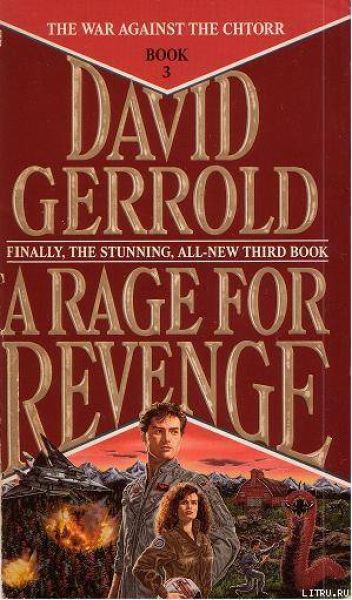The World Stood Still
A Rage for Revenge (The War Against The Chtorr, volume 3)
By David Gerrold

21 Oct, 2021
1989’s A Rage for Revenge is the third volume in David Gerrold’s The War Against the Chtorr series: a multipart tale of the ongoing and highly successful efforts of an alien ecosystem to remake Earth in their image.
Lieutenant James McCarthy signs up for Mode training, which is a bit like ESTif EST were to involve more verbal abuse and threats of physical violence. It soon becomes clear that McCarthy suffered something even worse than his usual bad luck. Cue lengthy flashback!
Readers triggered by child abuse will want to stop reading right now.
While on patrol with a doomed redshirt who won’t live long enough to be worth naming, McCarthy is ambushed and captured by Jason Delandro’s cult. Believing he can be of more use to the government if he survives and escapes, McCarthy submits to and joins the cult. He intends this to be a ruse; he’s buying time in which to escape.
It turns out the gap between a convincing ruse and actual brainwashing is smaller than McCarthy anticipated. The cult is quite aware that he played along while planning to flee later. They do not offer him a chance to run away. McCarthy spends more time living with the cult and participating in their daily life than he had planned.
Good news: the cult has found a way to co-exist with Chtorran ecosystems. Bad news: humans are well down the food chain and it’s not clear, particularly given their habit of tossing babies to the alien carnivores, that long term population will be stable or whether this will end in extinction. Worse news: on top of the whole feeding babies to monsters deal, the cult is quite keen on fucking children, an activity in which McCarthy takes part.
Eventually, McCarthy manages to escape. Traumatized, he finds a new life tending to orphans left in the wake of the Chtorran invasion. This proves a very bad idea, even beyond the obvious reasons. He may be done with the cult, but the cult is not done with him. Those orphans in whose wellbeing McCarthy is now so invested? Mere collateral damage.
~oOo~
The only reason I didn’t nope out of this was because I was paid to review it. It was still a very close run. The incessant limericks did not help.
Rage exhibits most of the problems on display in previous instalments, doubles down on them, and adds some new ones. The lectures are even more interminable [1] as is the macho posturing. Admittedly, because non-Americans play a very small role in this volume, the usual AMERICA FUCK YEAH! aspect is dialed back. Unfortunately, Gerrold replaces xenophobia with kiddie diddling, which not an actual improvement. Granted, this is a novel in the Heinlein mode; highly inappropriate relationships between adults and the kids unlucky enough to be in proximity to them are nigh obligatory.
Readers following the series for the cool Chtorran biology will be disappointed. We learn a bit more about how the invasion ecosystem works, but not much more. The book does make it explicit that terrestrial humans as we know them are probably doomed, either to extinction or to relegation to a status as useful domestic animal. If independent humans survive, it will be in space colonies.
While we don’t get a demographic assessment of the space colonies, we do get one for the threat management group associated with Mode Training. It is predominantly white. When this is noted, the answer for this situation is as follows:
“Yes, it’s true. There are too many white faces in here. Particularly since the Chtorran plagues were far more devastating in their effects against members of the Caucasian and Asian races than they were against Negroes[2]. So you can certainly look at the proportion of skin colors in this room and see that as evidence of discrimination-if you want to. And if that’s what you want to do, then no assertions that race was not a consideration in the selection process will satisfy you. If you’re looking for discrimination, you can always find evidence.”
One wonders if it will somehow turn out that most of the people tapped for the space colonies, no doubt also selected entirely on merit, were also white?
In short, by far the worst of the series. It’s astonishing Ragedidn’t kill the series. I suspect had I read the books in the correct order, I would have been a lot more positive about A Season for Slaughter because while it wasn’t especially good, it was better than Rage.
A Rage for Revenge is available here (Amazon US) and here (Amazon Canada). Rage is also available here (Amazon UK), here (Barnes & Noble), and here (Chapters-Indigo) but only in audiobook form. I did not find it at Book Depository.
1: it’s a bad sign when a book begins with a warning from the authorthat the book is didactic.
2: “Negroes” seems kind of archaic for a book published in 1989.
